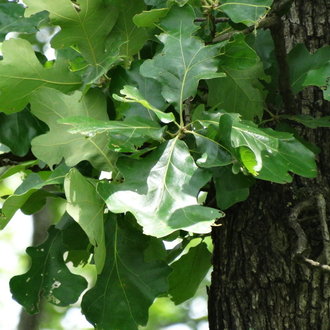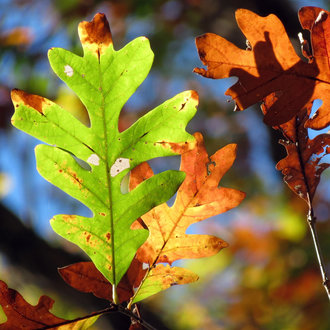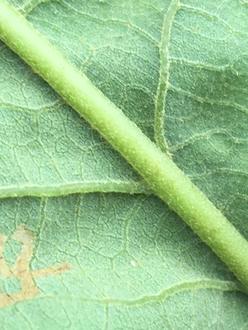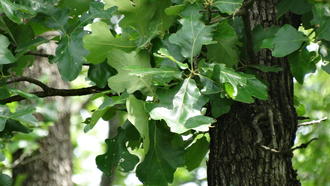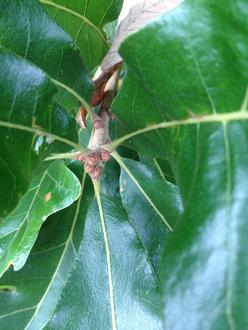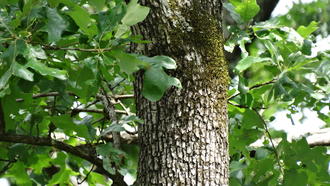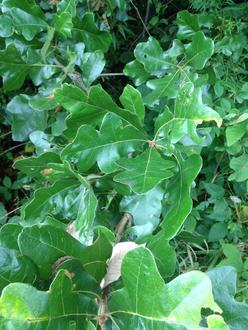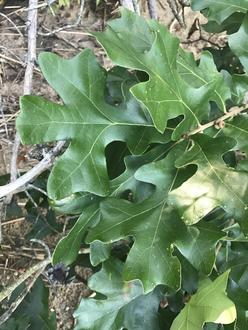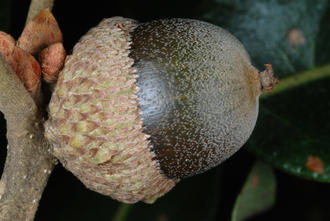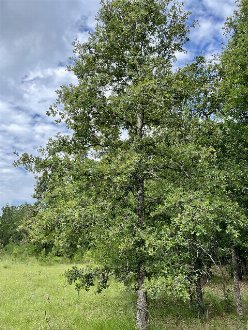Post Oak (Quercus stellata Wangenh.)
↑Summary
A resilient, slow-growing oak usually found on drier sites with poor soil.
↑Description & Identification
A tree, usually reaching a maximum of 50 to 60ft, rarely to 100ft, and usually only 30-40ft in the drier portions of its range. Broad, dense crown contains numerous horizontal branches. Often looks gnarled or shrubby.
Leaves are variable in shape, but often have a distinctive cross shape, with 5-7 rounded lobes, the center lobes usually largest and rectangular in shape. Leaf texture is leathery; leaves are shiny, dark green, and rough-textured, paler and with grayish or yellowish hairs underneath.
Young twigs initially have yellowish hairs, which darken with age and are often absent by autumn.
↑Similar Plants
↑Habitat
Post oak is usually found on dry, nutrient-poor uplands that are barely rich enough to support tree cover.
At the western border of its range, post oak is dominant in upland savannas and open forests adjacent to grasslands. It is common in the transition between upland prairies and forests in Oklahoma and Texas. Farther east, it is restricted to rock outcroppings, dry ridges, upper slopes facing west or south, pine barrens with excessively-drained sands, shale barrens, or serpentine barrens.
Post oak usually occurs on sandy to gravely soils low in nutrients and organic matter. It is typically found on sites where a layer of heavy clay, gravel, or rock is overlain by shallow sand; it is usually absent from deep sands. It tends to occur on sites too dry for white oak (Quercus alba) and southern red oak (Quercus falcata), but moister than blackjack oak (Quercus marilandica), although it can co-occur with all these species. It overlaps most in habitat with blackjack oak. Although it can occur on higher pH soils in certain specific conditions, it is usually found on acidic soils.
Its western range is limited by low rainfall, where it suffers from its inability to survive flooding: as one proceedes farther west, suitable total moisture levels occur only in bottomlands. At the northwest limit of its range it is replaced by bur oak (Quercus macrocarpa) in savannas, whereas in the southwest of its range it is similarly replaced by chinquapin oak (Quercus muehlenbergii). Both these species better tolerate both flooding and alkaline soil. Its northern range is likely limited by the cool, humid conditions in New England and the northern portions of the Midwest, where even the driest sites are too moist for it to compete with other vegetation. In these regions it is replaced by black oak (Quercus velutina) or scarlet oak (Quercus coccinea) on the driest sites, which outcompete it as black oak is more shade-tolerant and scarlet oak grows faster.
Post oak is intolerant of shade and either not present on, or only present in early successional stages of habitats with richer vegetation. Although shade-intolerant, it is considered an edaphic climax species on drier sites, as it tends to form a stable community on sites where fire and/or drought kill competing vegetation. It is usually only found as a successional relict species on sites that formerly had poor soil, as its slow growth makes it unable to compete with early-successional growth on richer sites.
Fire suppression can cause it to move into prairies in the west of its range, and in habitats formerly dominated by longleaf pine in the coastal plain in the east of its range. However, in the more humid portions of its range, fire suppression can also cause it to be eliminated from sites and replaced by more shade-tolerant vegetation. It is usually absent from habitats that never experience fire.
↑Life Cycle
Post oak is slow growing, even among oaks. Seedlings are resistant to drought but not flooding. Seedlings develop thick taproots, but most roots develop above the rocks or hard clay horizons that usually underlie the soils where this species is found.
Seed production typically begins around 25 years of age, and good seed crops occur at 2-3 year intervals. Seed production is low relative to other oaks found in dry habitats, such as white, blackjack, black, or scarlet oaks.
Acorns germinate shortly after falling, and germination is best when covered in 1 inch or more of leaf litter.
Top-killed trees resprout vigorously, and resprouts tend to grow faster than seedlings. This species produces fewer sprouts per stump than most other oaks.
Trees sometimes reproduce vegetatively, sending up new shoots from more distant sites on roots. Such vegetative reproduction can occur in response to moisture stress, and can sometimes lead to clonal colonies of up to six trunks.
Individual trees may live 300-400 years. Mortality can occur from a wide range of causes. Typically, trees are not directly caused by one factor, but rather, become gradually stressed and then succumb to insect infestations or fungi that would not normally harm a healthy tree. Factors caused trees to become stressed include severe drought and flooding. Trees can also die if they become overtopped by taller vegetation, which can occur as soil under the trees continues to develop and accumulate, especially in the absence of fire.
↑Faunal Associations
As the largest tree in many of the habitats in which it occurs, post oak provides a critical structural role in the ecosystem and is thus of key importance as cover and for habitat for birds and mammals. Cavities in older trees provide nesting sites, and the leaves are used as nesting materials. The acorns are a key food source for deer, wild turkey, and squirrels, as well as other small mammals and larger birds. Deer occasionally browse on foliage and twigs, but usually only sparsely as the leaves are tough and both leaves and buds are high in tannins.
Post oak supports a wide variety of insects, mostly the same complex that eat other oaks, especially those of the white oak group. In general oaks support both a high volume and diversity of insects.
Lepidoptera that have been recorded eating this plant include the solitary oak leafminer (Cameraria hamadryadella), the oak leafminers Phyllonorycter basistrigella and Phyllonorycter fitchella, Horace's duskywing (Erynnis horatius), Juvenal's duskywing (Erynnis juvenalis), the oak hairstreak (Satyrium favonius), the moth Stilbosis victor, the scalloped sack-bearer (Lacosoma chiridota), the girlfriend underwing (Catocala amica), the scarlet underwing (Catocala coccinata), the little nymph underwing (Catocala micronympha), the similar underwing (Catocala similis), the ashy meganola (Meganola spodia), the variable oakleaf caterpillar moth (Lochmaeus manteo), the moth Menesta melanella, the yellow-vested moth (Rectiostoma xanthobasis), the spiny oakworm moth (Anisota stigma), the pin-striped oakworm moth (Anisota virginiensis), Grote's buck moth (Hemileuca grotei), the stinging buck moth (Hemileuca maia), the generalist polyphemus moth (Antheraea polyphemus), io moth (Automeris io
) yellownecked caterpillar (Datana ministra), eastern tent caterpillar (Malacosoma americana), forest tent caterpillar moth (Malacosoma disstria), and Sonoran tent caterpillar (Malacosoma tigris), and the introduced generalist spongy moth (Lymantria dispar). This list is likely incomplete.
Post oak is the preferred host for a number of leafhoppers: Eratoneura igella, Eratoneura inepta, Eratoneura millsi, Eratoneura parva, Eratoneura tammina, Eratoneura tantilla and Eratoneura ungulata.
Numerous other lineages of insects eat this species as well, including beetles, aphids, and other true bugs.
↑Uses
Post oak is occasionally used as a landscaping plant, where it is valued for its extreme drought tolerance, small maximum size among oaks, and its longevity. Its use is limited by its slow growth and poor tolerance of flooding. When planted in landscaping, it can sometimes grow to larger sizes than it typically occurs in the wild.
It is suitable for drier sites in urban environments, and on sites with good drainage, can be used as a street tree, where it both thrives and requires less pruning due to it slower growth and small size.
Post oak is occasionally used for timber, where it is sometimes lumped together with other white oak. It has low commercial importance, however, due to its slow growth, small maximum size, and tendency to have significant insect damage on most trees. The wood is hard, highly durable and has good decay resistance. The name "post oak" comes from the fact that this species is frequently used for fence posts. It is also used for railroad ties, mining timbers, flooring, siding, and construction. Its properties make it ideal for load-bearing applications where smaller pieces are acceptable.
↑Related Plants
Quercus stellata overlaps with numerous other oaks of the white oak group, and it can readily hybridize with many of them. It is the northernmost-ranging of a lineage of more southerly oak species that is mostly limited to Texas and northern Mexico. It is probably closest-related to bottomland post oak (Quercus similis), followed by Boynton sand post oak (Quercus boyntonii).
After these it is probably most closely related to a group of oaks including havard oak (Quercus havardii), sand post oak (Quercus margaretta), chapman oak (Quercus chapmanii), and bastard white oak (Quercus austrina).
Followed by these it is then related to oglethorpe oak (Quercus oglethorpensis), and then bastard oak (Quercus sinuata).
Although the above oaks are more closely-related, hybrids are more likely to form with other species that overlap more in range and bloom time. The hybrid with white oak (Quercus alba), fernow oak (Quercus ×fernowii), is relatively widespread throughout most of the range of overlap, and to our knowledge is the only hybrid that occurs commonly, although it is possible that other hybrids are underreported.
Less commonly, it hybridizes with swamp white oak (Quercus bicolor) to form Quercus ×substellata, with bastard oak (Quercus sinuata) to form Quercus ×macnabiana, with havard oak (Quercus havardii) (although we could not find a name for this hybrid), with overcup oak (Quercus lyrata) to form Quercus ×sterrettii, with bur oak (Quercus macrocarpa) to form Quercus ×guadalupensis, with dwarf live oak (Quercus minima) to form Quercus ×neo-tharpii, with mohr oak (Quercus mohriana) (we also could not find the name for this hybrid), with dwarf chinquapin oak (Quercus prinoides) to form Quercus ×stelloides, and chestnut oak (Quercus montana) to form Quercus ×bernardiensis, and with live oak (Quercus virginiana) to form Quercus ×harbisonii. As with other oak hybrids, it is likely that these and possibly other hybrids are underreported due to the difficulty of oak identification.
↑Notes
The fungus that cuases chestnut blight, Cryphonectria parasitica, can also affect post oak, although it is less likely to kill the tree.
↑Links & External Resources
• Post Oak | The Wood Database (About This Site)
• Post Oak | Fire Effects Information System (FEIS) (About This Site)
• Quercus stellata (Post Oak) | Illinois Wildflowers (About This Site)
• Quercus stellata (Post Oak) | USDA PLANTS Database (About This Site)
• Quercus stellata | Go Botany (About This Site)
• Post Oak | iNaturalist (About This Site)
• Quercus stellata (Post Oak) | Missouri Botanical Garden Plant Finder (About This Site)
• Post Oak | Virginia Tech Dendrology Factsheets (About This Site)
• Post Oak | Silvics of North America (About This Site)
• Quercus stellata | Biota of North America Project (BONAP) (About This Site)
• Quercus stellata Wangenh. | Plants of the World Online (POWO) (About This Site)
• Quercus stellata | NatureServe Explorer (About This Site)
• Quercus stellata | Flora of North America (About This Site)
• Post Oak | Maryland Biodiversity Project (About This Site)
• Quercus stellata Wangenheim (Post Oak) | Digital Atlas of the Virginia Flora (About This Site)



